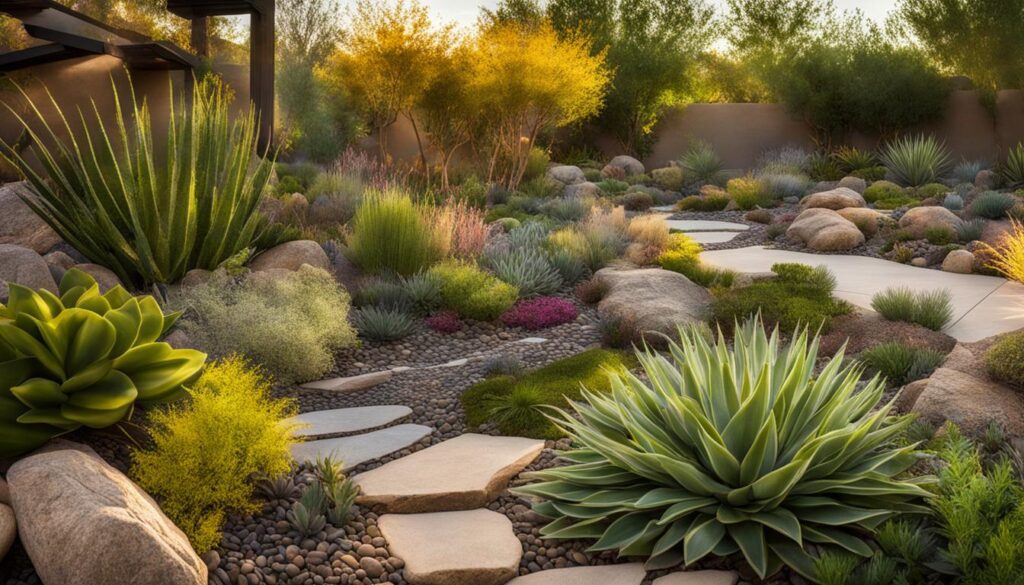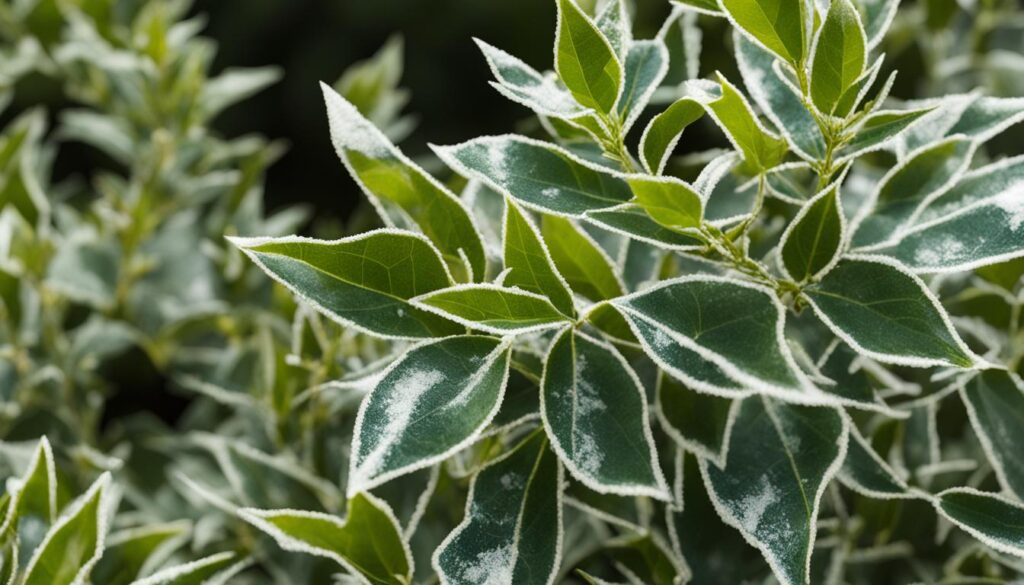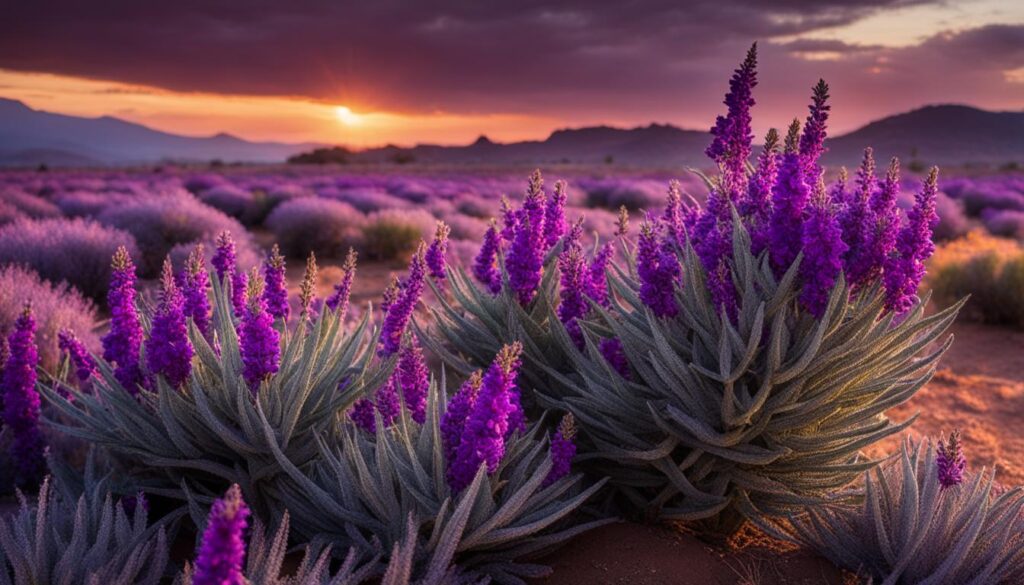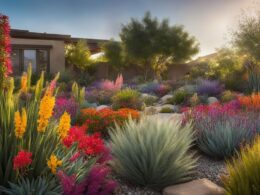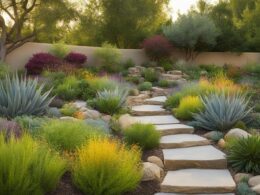Are you a homeowner looking to beautify your landscape while also reducing water usage? Consider incorporating water-saving xeriscape plants into your outdoor space. Xeriscaping is a landscaping strategy that focuses on water conservation and utilizes drought-tolerant plants. By embracing xeriscaping, you can create stunning and sustainable landscapes that require minimal maintenance and watering. Let’s explore the benefits and plant options for homeowners interested in reducing water usage and creating a more eco-friendly environment.
Key Takeaways:
- Water-saving xeriscape plants are excellent for homeowners looking to reduce water usage in their landscapes.
- Xeriscaping promotes water conservation, cost-effectiveness, and eco-friendliness.
- When selecting plants for xeriscaping, opt for drought-tolerant options that require minimal watering.
- Sunbird Aloes, Atriplex Silver Holly, Dianella, Mediterranean Sage, and Eremophila are fantastic choices for water-saving xeriscape plants.
- Xeriscaping offers homeowners a sustainable alternative to traditional lawns, supporting a greener and more water-efficient world.
The Benefits of Xeriscaping for Homeowners
Xeriscaping offers numerous benefits for homeowners. Firstly, it promotes water conservation by reducing the need for excessive watering. By incorporating water-saving xeriscape plants into your landscape, you can significantly decrease water usage and contribute to the sustainability of our water resources. This not only helps to conserve water but also decreases water bills, making xeriscaping a cost-effective choice in the long run.
In addition to water conservation, xeriscaping is also a highly cost-effective landscaping strategy. By selecting drought-tolerant plants that require less maintenance and irrigation, you can save both time and money on your landscape upkeep. Xeriscaped landscapes require minimal watering and are designed to thrive in dry conditions, reducing the need for constant maintenance and expensive irrigation systems.
Furthermore, xeriscaping is an eco-friendly approach to landscaping. By minimizing water usage, xeriscaped landscapes help to conserve water resources and reduce the strain on local ecosystems. Additionally, traditional lawns require frequent mowing and the use of fertilizers, which can contribute to pollution and harm the environment. By replacing lawns with water-saving xeriscape plants, you can decrease pollution from lawnmowers and fertilizers while supporting local biodiversity.
Xeriscaping Benefits at a Glance:
- Water conservation and reduced water bills
- Cost-effective landscaping with minimal maintenance
- Eco-friendly approach that supports local biodiversity
- Decreased pollution from lawnmowers and fertilizers
By embracing xeriscaping, you can create a beautiful and sustainable landscape that not only enhances the aesthetic appeal of your outdoor space but also contributes to a greener, more water-efficient future.
Selecting Drought-Tolerant Plants for Xeriscaping
Incorporating drought-tolerant plants into your xeriscape is crucial to achieving a water-efficient and sustainable landscape. By selecting plants that thrive in dry conditions and require minimal watering, you can create a visually appealing and eco-friendly outdoor space. Here are some popular options:
- Lantana: This vibrant plant is drought-tolerant and attracts pollinators with its colorful flowers.
- Coneflower: Known for its resilience, coneflowers bloom in various colors and add texture to your xeriscape.
- Pink Muhly Grass: With its delicate pink plumes, this grass creates a stunning focal point while requiring little water.
- Lavender: Not only does lavender thrive in dry conditions, but it also releases a calming scent and attracts beneficial insects.
- Sage: This aromatic herb is drought-tolerant and features attractive foliage and flowers.
Additionally, consider incorporating red emu bush, shrubby germander, and succulents such as agave and aloe. These plants not only add visual interest but also contribute to the water-saving nature of your xeriscape.
“Incorporating drought-tolerant plants into your xeriscape is crucial to achieving a water-efficient and sustainable landscape.”
Table: Comparison of Drought-Tolerant Plants
| Plant | Drought-Tolerance | Flower/Foliage | Other Benefits |
|---|---|---|---|
| Lantana | High | Colorful flowers | Attracts pollinators |
| Coneflower | High | Various colors | Texture |
| Pink Muhly Grass | High | Pink plumes | Focal point |
| Lavender | High | Aromatic foliage, flowers | Fragrance, attracts beneficial insects |
| Sage | High | Foliage, flowers | Aromatic |
When selecting drought-tolerant plants for your xeriscape, it’s essential to consider their water needs, visual appeal, and ability to thrive in your specific climate. By choosing the right plants, you can create a beautiful and sustainable landscape that conserves water and minimizes maintenance.
Sunbird Aloes – Winter Wonderland of Color
When it comes to adding vibrant colors to your xeriscaped garden, Sunbird Aloes are an excellent choice. These stunning plants offer a winter wonderland of color and bring architectural interest to your outdoor space. With their mesmerizing mix of hues, Sunbird Aloes create a visual spectacle that is sure to captivate any onlooker.
One of the standout qualities of Sunbird Aloes is their ability to thrive in drought conditions. These plants are highly drought-resistant, making them perfect for xeriscaping where water conservation is a priority. By choosing Sunbird Aloes for your garden, you can enjoy their remarkable beauty while keeping your water usage to a minimum.
Not only do Sunbird Aloes add a pop of color to your landscape, but they also attract pollinators and contribute to local biodiversity. Their bright blooms provide a valuable food source and habitat for bees, butterflies, and other beneficial insects. By including Sunbird Aloes in your xeriscape, you are creating a welcoming environment for these important pollinators.
| Sunbird Aloes | Attributes |
|---|---|
| Color Palette | A mesmerizing mix of vibrant hues, including shades of red, orange, and yellow. |
| Winter-Blooming | Produces stunning blooms during the winter months, adding color to your garden when most other plants are dormant. |
| Drought-Resistant | Thrives in dry conditions and requires minimal watering, making it an ideal choice for water-saving xeriscaping. |
In summary, Sunbird Aloes are the perfect addition to any xeriscaped garden, offering a winter wonderland of color, drought resistance, and the ability to attract pollinators. With their vibrant blooms and architectural interest, these plants will transform your outdoor space into a visually stunning oasis. Embrace the beauty and sustainability of Sunbird Aloes as you create a water-efficient and captivating xeriscape.
Atriplex Silver Holly – Dazzling Beauty
Atriplex, or Silver Holly, is another great plant for xeriscaping. This plant is known for its dazzling beauty and remarkable resistance to drought, salt, and wind. The distinctive silver-grey foliage of Atriplex creates a stunning contrast and adds a unique visual appeal to any xeriscaped space. Additionally, it serves as a habitat and food source for local fauna, making it a wildlife-friendly choice.
| Plant Name | Drought Resistance | Foliage Color |
|---|---|---|
| Atriplex Silver Holly | Drought-resistant | Silver-grey |
With its resilience to harsh environmental conditions, Atriplex Silver Holly thrives in areas with limited water availability and can withstand high levels of salinity and wind. This makes it an excellent choice for homeowners who want to create a beautiful and low-maintenance xeriscape while conserving water resources.
Atriplex Silver Holly offers a stunning visual display with its silver-grey foliage, bringing a touch of elegance to any xeriscape. Its ability to withstand drought, salt, and wind makes it a resilient and low-maintenance option for sustainable landscaping.
By incorporating Atriplex Silver Holly into your xeriscape, you can create a vibrant and visually appealing outdoor space that requires minimal water and maintenance. Its dazzling beauty and ability to support local fauna make it a standout choice for those looking to transform their landscapes into sustainable havens of natural beauty.
Dianella – Versatile Charm
Dianella, also known as flax lilies, brings versatile charm to xeriscaped gardens. With their strappy leaves and delicate star-shaped flowers, these plants add a unique textural element to the landscape. Dianella is drought-tolerant, adaptable to various soil types, and can withstand frost and drought. They come in different foliage colors and flowering patterns, offering diverse aesthetics without compromising water efficiency.
Dianella Varieties
If you’re considering incorporating Dianella into your xeriscape, you have several varieties to choose from. Here are a few popular options:
- Dianella caerulea (Blue Flax Lily) – This native Australian variety features striking blue-green foliage and produces clusters of blue or purple flowers.
- Dianella tasmanica (Tasman Flax Lily) – Known for its broad, arching leaves and vibrant blue flowers, this variety adds a pop of color to any xeriscape garden.
- Dianella revoluta (Black Anther Flax Lily) – With its bold, dark purple flowers and glossy green leaves, this variety creates a dramatic focal point in a xeriscaped landscape.
By choosing the right Dianella varieties for your xeriscape, you can create a visually stunning and water-efficient garden that thrives in various conditions.
Table: Dianella Varieties Comparison
| Variety | Foliage Color | Flower Color | Water Requirement |
|---|---|---|---|
| Dianella caerulea (Blue Flax Lily) | Blue-green | Blue or purple | Drought-tolerant |
| Dianella tasmanica (Tasman Flax Lily) | Green | Blue | Adaptable |
| Dianella revoluta (Black Anther Flax Lily) | Green | Dark purple | Drought-tolerant |
The table above provides a comparison of different Dianella varieties, showcasing their foliage and flower colors, as well as their water requirements. This information can help you choose the right Dianella variety for your xeriscape, based on your aesthetic preferences and water-saving goals.
Drought-Tolerant Mediterranean Sage for Vibrant and Fragrant Gardens
If you’re looking to add vibrant flowers and fragrant foliage to your xeriscaped garden, Mediterranean Sage is an excellent choice. This drought-tolerant perennial plant, scientifically known as Salvia officinalis, not only adds a pop of color but also attracts beneficial pollinators.
Mediterranean Sage thrives in sunny, well-drained areas, making it a perfect fit for xeriscaped landscapes. Its tall spikes of purple or blue flowers create a stunning visual display throughout the season. The fragrant foliage adds an extra sensory element to your garden, making it a delight for both sight and smell.
With its water-wise nature, Mediterranean Sage embodies the principles of xeriscaping. It requires minimal watering once established, making it an ideal choice for water-efficient landscaping. By incorporating Mediterranean Sage into your xeriscape, you can create a vibrant and sustainable outdoor space that conserves water and supports local ecosystems.
Benefits of Mediterranean Sage in Xeriscaping:
- Requires minimal watering once established
- Attracts beneficial pollinators
- Provides a stunning visual display with tall spikes of purple or blue flowers
- Emits a fragrant aroma from its foliage
- Thrives in sunny, well-drained areas
- Supports water conservation efforts
By incorporating drought-tolerant Mediterranean Sage into your xeriscaped garden, you can enjoy a vibrant and fragrant outdoor space while minimizing water usage and promoting sustainable landscaping practices.
Eremophila – An Australian Native
Embrace the beauty and resilience of Australian flora with Eremophila, commonly known as Emu Bush. These stunning plants are drought-tolerant and perfect for xeriscaping, allowing you to create a vibrant and sustainable garden. With their vivid flowers and minimal water needs, Eremophilas add a splash of color to any landscape.
Native to Australia, Eremophilas have adapted to thrive in harsh environments, making them an excellent choice for xeriscapes. Their silver-grey foliage provides an attractive contrast to the vibrant flowers, creating a visually striking display. Whether you choose the rich reds, purples, or pinks, Eremophilas will bring a touch of Australia’s natural beauty to your garden.
Not only are Eremophilas drought-tolerant, but they also require little maintenance. Once established, these hardy plants can withstand various soil types and climates, making them suitable for both arid and temperate regions. By incorporating Eremophilas into your xeriscape, you can conserve water and create an environmentally-friendly outdoor space that flourishes year-round.
Table: Varieties of Eremophila
| Variety | Flower Color | Height | Drought-Tolerance |
|---|---|---|---|
| Eremophila maculata | Red, Pink, Purple | 3-6 feet | High |
| Eremophila glabra | Purple, White, Yellow | 2-4 feet | High |
| Eremophila nivea | White, Yellow | 2-3 feet | Moderate |
| Eremophila drummondii | Pink, Purple | 2-3 feet | High |
These are just a few of the many varieties of Eremophila available for xeriscaping. Each variety offers its unique beauty and characteristics, ensuring there is something for every garden. Whether you want a burst of color, a striking focal point, or a low-maintenance ground cover, Eremophilas have you covered.
Eremophilas are a testament to the resilience and adaptability of Australian plants. By incorporating these drought-tolerant beauties into your xeriscape, you can create a stunning landscape that thrives in even the toughest conditions. Let Eremophilas bring the vibrant colors of the Australian outback to your garden and embrace the water-wise ethos of xeriscaping.
Transforming Landscapes with Xeriscaping
Xeriscaping is a transformative approach to landscaping that combines aesthetic appeal with environmental responsibility. By understanding the benefits of xeriscaping and selecting the right plants, homeowners can create beautiful, low-maintenance landscapes that conserve water and support local ecosystems.
One of the key aspects of xeriscaping is its focus on sustainable practices. By using drought-tolerant plants and minimizing water usage, xeriscaped landscapes help conserve one of our most precious resources. This not only benefits the environment but also reduces water bills for homeowners. With xeriscaping, you can have a stunning outdoor space while being mindful of water efficiency.
In addition to water conservation, xeriscaping has numerous other benefits. These landscapes require less maintenance and irrigation compared to traditional lawns, saving both time and money. Xeriscaped gardens also support local biodiversity by providing habitats and food sources for pollinators and other wildlife. Furthermore, xeriscaping reduces pollution from lawnmowers and fertilizers, contributing to a cleaner and healthier environment.
By embracing xeriscaping, homeowners can play a significant role in creating a greener and more sustainable world. Whether you have a small suburban yard or a sprawling estate, xeriscaping offers a range of options to suit your preferences and local climate. From colorful Sunbird Aloes to the versatile charm of Dianella and the vibrant Mediterranean Sage, there are numerous water-saving plants that can transform your landscape into a visually appealing and environmentally friendly space.
Benefits of Xeriscaping:
- Conserves water resources and reduces water bills
- Requires less maintenance and irrigation
- Supports local biodiversity and pollinators
- Reduces pollution from lawnmowers and fertilizers
Conclusion
Xeriscaping offers homeowners a way to create visually appealing and sustainable landscapes while reducing water usage. By selecting drought-tolerant plants such as Sunbird Aloes, Atriplex Silver Holly, Dianella, Mediterranean Sage, and Eremophila, you can transform your outdoor spaces into vibrant, low-maintenance gardens that conserve water and support local ecosystems.
Xeriscaping is more than just a landscaping trend; it’s a step towards a sustainable future and a testament to our potential to live in harmony with nature. Embrace xeriscaping and contribute to a greener, more water-efficient world.
With water-saving plants and sustainable landscaping practices, you not only create a beautiful and eco-friendly environment, but you also reduce your water consumption and minimize the need for maintenance. Xeriscaping allows you to have a stunning outdoor space while being environmentally responsible. So, why wait? Start your xeriscaping journey today and make a positive impact on the planet.
FAQ
What is xeriscaping?
Xeriscaping is a landscaping strategy that focuses on water conservation and the use of drought-tolerant plants.
Why should homeowners consider xeriscaping?
Xeriscaping promotes water conservation, reduces water bills, requires less maintenance and irrigation, and supports local biodiversity.
What types of plants are suitable for xeriscaping?
Popular options include lantana, coneflower, pink muhly grass, lavender, sage, red emu bush, shrubby germander, and succulents like agave and aloe.
What are the benefits of Sunbird Aloes for xeriscaping?
Sunbird Aloes offer a colorful palette, architectural interest, winter-blooming, hardiness, and attraction to pollinators and local biodiversity.
Why is Atriplex Silver Holly a great choice for xeriscaping?
Atriplex Silver Holly is drought-resistant, salt and wind tolerant, and adds dazzling beauty and silver-grey foliage to any xeriscaped space.
What makes Dianella suitable for xeriscaped gardens?
Dianella is drought-tolerant, adaptable to various soil types, frost and drought resistant, and adds textural charm with its strappy leaves and delicate flowers.
Why should homeowners consider Mediterranean Sage for xeriscaping?
Mediterranean Sage thrives in sunny, well-drained areas, attracts pollinators with its vibrant flowers, and provides a stunning visual display throughout the season.
What are the advantages of Eremophila in xeriscaping?
Eremophila is tough, drought-tolerant, adaptable to different soils and climates, and offers vivid flowers and grey-green foliage for a vibrant xeriscape.
How does xeriscaping transform landscapes?
Xeriscaping combines aesthetics with environmental responsibility, allowing homeowners to create beautiful, low-maintenance landscapes that conserve water and support local ecosystems.
What is the overall importance of xeriscaping and water-saving plants?
Xeriscaping offers a sustainable alternative to traditional lawns, minimizing water usage and contributing to a greener, more water-efficient world.






